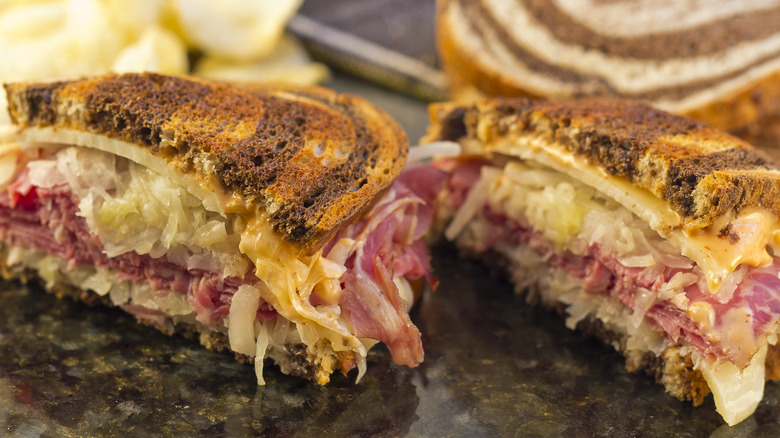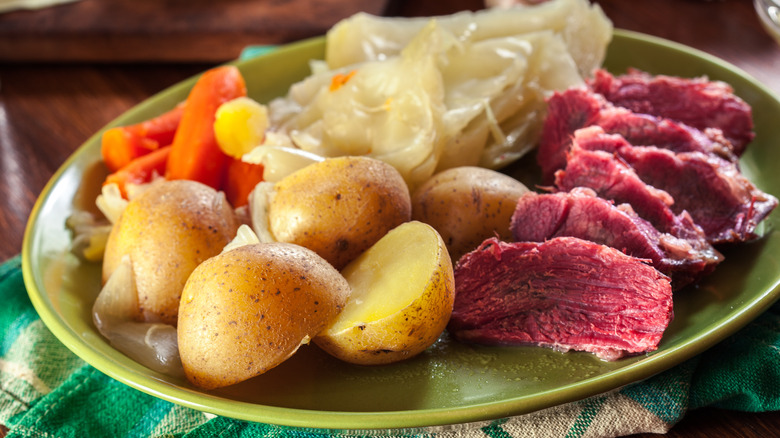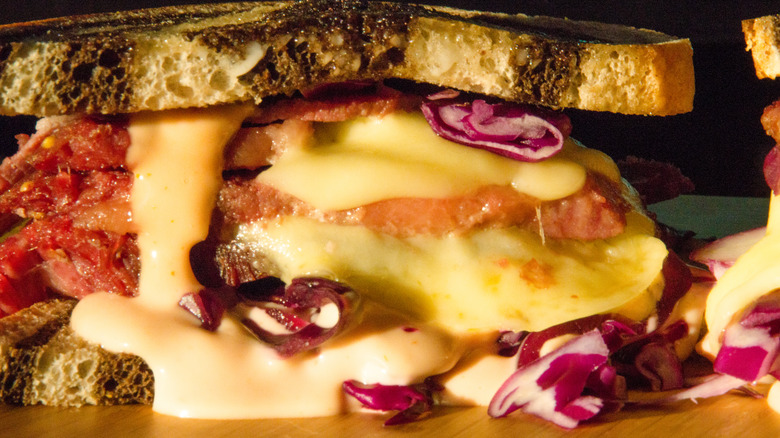Why Exactly Do We Eat Reubens On St. Patrick's Day?
To Americans, Saint Patrick's Day is the quintessential day to celebrate all things Ireland. After all, many of the immigrants forced to leave Ireland made their way to the U.S. Those homesick expats turned a quiet, religious day of family feasts when pubs were legally closed (until 1970) into what we know today. Green beer, shamrock shakes, and corned beef were never part of the celebration back home.
What came to be known as corned beef does, however, have a long history in Ireland. But, that long tradition of preserving beef was mostly something Ireland exported to more places with more beef-centric diets, such as England. It wasn't a common part of the Irish diet. So, that production history isn't why we eat corned beef and cabbage on St. Patrick's Day.
In the U.S., Irish immigrants often ended up being neighbors to Jewish delis, where corned beef was both familiar and affordable. A meal of simmered corned beef, potatoes, and the cheapest vegetable, cabbage, became a favorite way to feed a crowd.
Reubens might be the best way to celebrate St. Patrick's Day
What Irish people eat on St. Patrick's Day is more likely to be along the lines of colcannon, roasted Spring lamb, a fish pie, with some soda bread. All of those lovely meals would be ideal for a family feast. But seeing how St. Patrick's Day has become more about pub crawls in the United States, it makes sense that the food Americans eat is more portable. The Reuben sandwich is just the thing to grab and go on your way through some friendly local establishments.
The exact origins of the Reuben sandwich are many, and up for debate. Was it a steakhouse in Omaha, or a deli in New York? What's important is that a common meal people associate with Irish cuisine morphed into an iconic sandwich. Boiled cabbage gets a fermented upgrade into sauerkraut. Swiss cheese offers nutty complexity. Rye bread is a deli favorite to hold it all in place. It's all tied together with a condiment so unique to these shores, Thousand Island dressing is called American sauce in Germany.
Only the potato is missing from that origin meal, but we all know that no sandwich is complete without a bag of potato chips.
Make a Reuben from scratch
For something as undeniably delicious as a Reuben, it needs to be in your sandwich rotation more often than St. Patrick's Day. Any respectable deli should be able to scratch Reuben itch. But making a homemade version is worth the effort.
A classic deli Reuben sandwich recipe is all about gathering the right ingredients. Start in the deli department. Get the corned beef freshly sliced to the thickness you prefer. While you're there, get some slices of Swiss cheese. For the sauerkraut, choose a shelf-stable, jarred sauerkraut, versus the refrigerated bags. America's Test Kitchen's taste tests found that the plastic bags allow small amounts of air into the bags. To combat this from spoiling the sauerkraut, producers add preservatives that taint the bright, clean, cabbage funk. So, a jar is your best bet.
For the Thousand Island, grab your favorite bottle, or throw together a homemade version. Thousand Island dressing, at its most basic, is only three ingredients–mayonnaise, ketchup, and relish. Feel free to upgrade that trio with some chili sauce, diced hard-boiled egg, minced onion, or garlic. A splash of acidity, from lemon, or vinegar, is a good idea. Up the heat with cayenne or sriracha. A bit of honey, or sugar, can round it all out. Throw on some coleslaw and call it a Rachel.
Pile it up and griddle till the corned beef is warm, the cheese is melted, and the rye is crispy. Enjoy it any day of the year.


